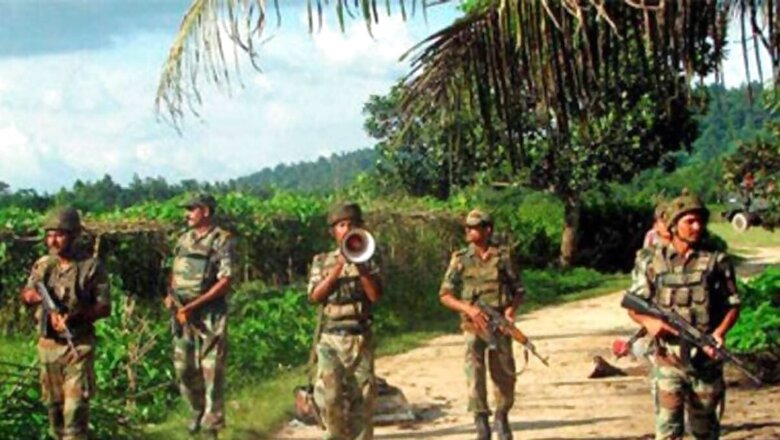
views
The zealousness with which ethnic identities have been seeking to come to the fore in the Northeast is fraught with danger. In the distant past, various tribes and communities coexisted in relative harmony. There were instances of Naga tribes warring against one another, but there was always an unspoken comprehension that ‘each-to-himself’ existed, even as they tussled. Indeed, it was with the advent of the Christian missionaries who sought to unify the ‘Nagas for Christ’ and later a pronouncement from New Delhi about the ‘unique history’ of a non-existent nationality that witnessed a cobbling together of an utterly disparate people into an uneasy conglomeration. Indeed, the Nagas of the present territory of Nagaland continue to harbour issues about the Tangkhul Naga community of Manipur. Furthermore, the ethnic contiguity that characterises the Nagas across boundaries has its own account of conflict.
However, at this time, the assertion of identities has paved the way—in a sense—to the institution of inter-ethnic alliances that have similar motivations—in this case, anti-New Delhism (in the political sense), and to a reckonable extent, an agenda that is anti-Indian as well.
In Manipur, it has been observed that despite the contradictions, the insurgent groups of the valley have entered into a ground alliance with the National Socialist Council of Nagalim-Isaak Muivah (NSCN-IM). But the fact of the matter is that NSCN-IM, primarily the leadership of the grouping which is largely from Ukhrul, would never countenance a peace accord with New Delhi without appropriating the Hills of Manipur, which is their homeland. On the other hand, the Valley-Based-Insurgent-Groups (VBIGs) such as the United National Liberation Front (UNLF) and People’s Liberation Army (PLA) of Manipur would never permit the Balkanisation of Manipur. After all, an insurgent group always mirrors its purported parish and it has to (despite uncomfortable crisscrossing and overlapping) garnish its ideology with the wishes of the people among whom it operates or professes to fight for. It would be recalled that when there was an “extension without territorial limits” to the Naga ceasefire in 2001, the entire Manipur valley was ablaze with an angry populace burning down the Manipur Legislative Assembly building.
But the truth is that R.K. Meghen of the UNLF met NSCN-IM leaders such as V.S. Atem and Anthony Shimray in 2022. While it is not known what exactly transpired, there is considerable speculation that an arrangement was worked out through which the VBIGs would be able to operate in the Hills of Manipur (and NSCN-IM in the valley).
Cartographical dissonances are not new for the Northeast. For instance, it was witnessed in Assam that the United Liberation Front of Asom (ULFA) and the National Democratic Front of Boroland (NDFB) had come into a ground alliance despite the fact that their “claimed areas” overlapped each other. The stratagem adopted, therefore, was to take on New Delhi first and then once the bigger war was won, the little battles would be waged!
But the fact remains that there is an ethnic divide in every nook and cranny of the Northeast. The ethnic cauldron that comprises Assam, for instance (and more importantly the chauvinism of mainstream Assamese society) has ascertained that almost every ethnic group in the state have been asserting their identity by either taking up arms or by demanding a separation from Assam. Ethnic assertion is a reality and has its roots in history. The faultlines have become more pronounced as a result of the neglect that the ethnic minorities are heir to.
Nirmal Nibedon, the celebrated observer of the Northeast, had warned about such peril in his seminal book, ‘North East India: The Ethnic Explosion’ — “It is the ethnic explosion. Make no mistake about it. Have no doubts about it. World governments, more so in India and the South East Asian countries, will have to closely study the case of the ethnic minorities, whether they are Kachins and Karens of Burma, the Mizos or the Ahoms of India. The ethnic minorities of India, particularly those of the Mongoloid stock, will deserve more attention. For, gone are the days when small bands of proud tribesmen fought and defended themselves with poison-tipped arrows. Today, in the 1980s, ethnic minorities are wielding sophisticated weapons and engaging national armies in combat, unceasingly. In brief, they are all zealously guarding their ethnic identity.”
It is the considered belief of this author that the internecine clashes that had taken place in the erstwhile N.C. Hills (now Dima Hasao) and Karbi Anglong could have been avoided, had mainstream Assamese society been more sensitive to the people of ‘Hill Assam.’ The clash was made out to be a conflict between Dimasas and Karbis, whereas, in reality, it was only so between the militant groups, Dima Halam Dauga (DHD) and United Peoples Democratic Solidarity (UPDS). It must also be recorded that the misgivings of ‘Hill Assam,’ particularly against mainstream Assam, had found other forms of manifestation as well. Much has been said about ULFA, Kakopathar and the explosions in Dhemaji and Guwahati, but little was known about the continuing violence in the tribal areas of Assam. The mayhem that took place in Imphal and thereabouts as a result of the extension of ceasefire with NSCN (IM) in 2001 has already been stated above. But it would interest the reader to learn that while there was uproar in the Manipur valley, only a few bordering districts of the state like Karbi Anglong and N.C. Hills—districts that do not raise the chauvinistic hackles of mainstream caste Hindu Assamese society—protested. Therefore, whereas Imphal burned in remonstration, Guwahati remained almost calm. It was pure chauvinism. Guwahati could not be bothered about its Hill districts.
The prognosis at this point in time, therefore, is that there could be more internecine strife and violence in the Bodo, Karbi and Dimasa-dominated areas in the future, with possible spillover effect to other areas, especially against the neglect by Assamese middle-class chauvinism. The government must reconstruct the scenario afresh and take steps to redress the development imperatives of the communities that groups such as Bodo, Mising, Karbi and Dimasa claim to represent—at the very least, insurgent groups in the Northeast cannot function effectively without support from its parish. This coupled with the unveiling of robust and comprehensive agreements with the groups with which ceasefires have been signed would have a salutary effect.
An important aspect that the government might consider is the incentive that should be provided to a group that seeks to cease hostilities. While this author is not recommending financial awards to groups for ceasing hostilities (an earlier column actually recommended “rule-based amnesty” that would not provide quarter to an insurgent/terrorist for heinous crimes committed), the reality is that maladies such as extortion could perhaps be controlled to an extent if “controlled incentives” are provided for the economic rehabilitation of such groups. Indeed, the present time poses as the correct time for the Government of India to intervene and cobble out arrangements with all groups that are ready to abjure violence and abide by the Indian Constitution. This is so because public sympathy for the smaller groups of the region is on the wane, and a “fatigue factor” seems to have set in. Moreover, it would be prudent for the government to iron out the smaller irritants now, as much of its energies would have to be spent in dealing with a more difficult state of affairs later.
However, this author also appreciates the predicament of the state in this regard. What can New Delhi possibly offer to such groups by way of a comprehensive package? One of the ways the problem can be circuited is to keep a few kitties away from the gaze. In the case of NDFB, all the SOPs were handed over to an earlier insurgent group, BLT (now BPPF), leaving almost nothing for the day when NDFB would come over ground. Gratefully, NDFB has been momentarily quietened. An alert Special Branch of the Assam Police saw to that. But there is a fear that some other faction might raise its ugly head. The cottage industry that the Northeast insurgency has graduated to will continue to witness periodic upheavals. Therefore, perspective planning is important. Mere juggling around with tremulous permutations of Saam (cajolement), Daam (monetary inducement), Dand (punitive action) and Bhed (Division) would not amount to anything except the creation of Imperilled Frontier-Phase II.
Jaideep Saikia is a Conflict Theorist and Author of Several Bestselling Books. Views expressed are personal.
Read all the Latest Opinions here

















Comments
0 comment